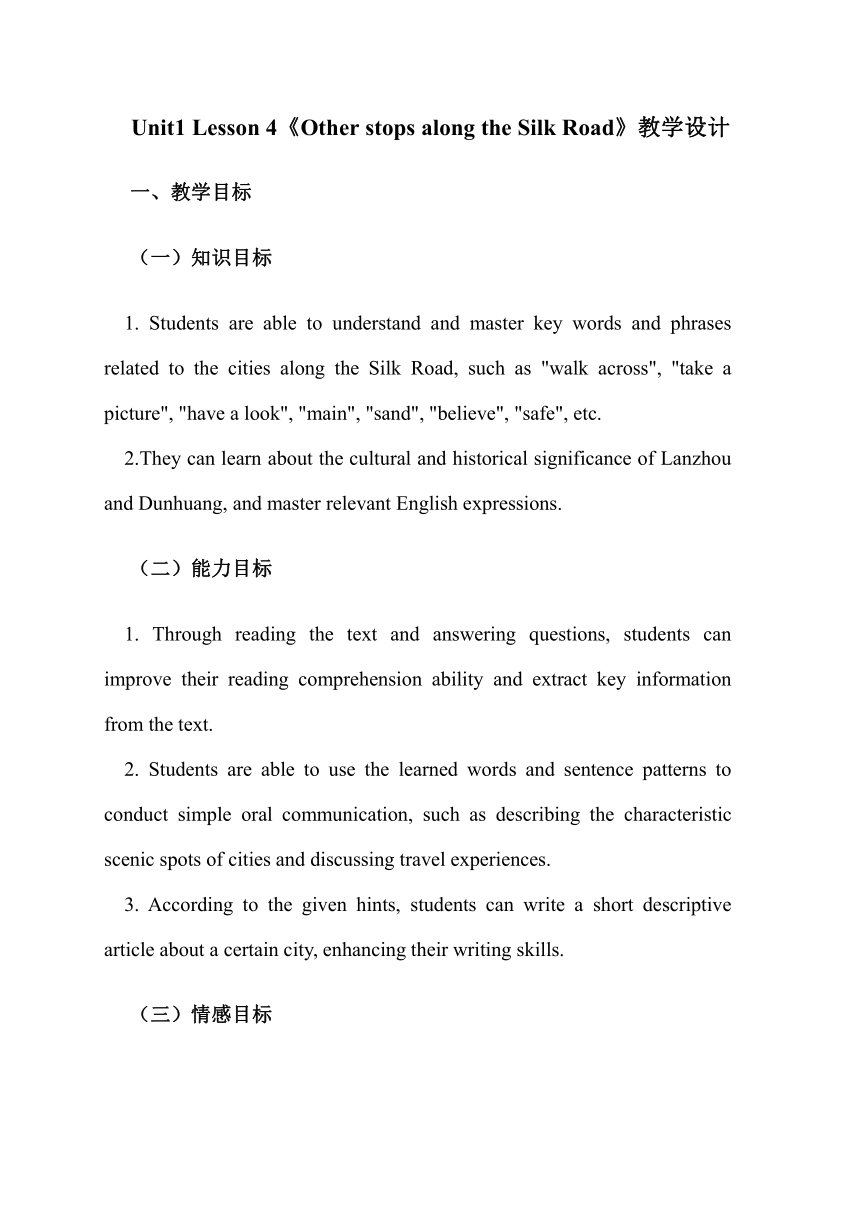
Unit1 Lesson 4《Other stops along the Silk Road》教学设计 一、教学目标 (一)知识目标 1. Students are able to understand and master key words and phrases related to the cities along the Silk Road, such as "walk across", "take a picture", "have a look", "main", "sand", "believe", "safe", etc. 2.They can learn about the cultural and historical significance of Lanzhou and Dunhuang, and master relevant English expressions. (二)能力目标 1. Through reading the text and answering questions, students can improve their reading comprehension ability and extract key information from the text. 2. Students are able to use the learned words and sentence patterns to conduct simple oral communication, such as describing the characteristic scenic spots of cities and discussing travel experiences. 3. According to the given hints, students can write a short descriptive article about a certain city, enhancing their writing skills. (三)情感目标 1. Cultivate students' curiosity and interest in Chinese history and culture, and enhance their cultural identity. 2. Encourage students to actively participate in classroom activities, and cultivate their teamwork spirit and autonomous learning ability. 二、教学重难点 (一)教学重点 1. Master key words and phrases, and understand their usage in context. Comprehend the main content and details of the text about Lanzhou and Dunhuang, including scenic spot introductions, history and culture, etc. Learn to use the learned knowledge for oral and written expressions. (二)教学难点 1. Be able to describe a city in a coherent and accurate English, and organize the article structure and language expressions well. 2. Guide students to actively use English to express their views and ideas in group discussions and exchanges, and overcome expression barriers. 三、教学方法 1. Situational Teaching Method: By showing pictures, playing videos, etc., create situations related to the cities along the Silk Road, allowing students to experience the local cultural atmosphere and stimulating their learning interests. 2. Task - driven Method: Assign tasks such as reading, writing, and oral expression, so that students can actively learn and use English knowledge in the process of completing tasks, and improve their language skills. 3. Group Cooperative Method: Divide students into groups for group discussions and cooperative task - completion, cultivating students' teamwork ability and communication skills. 四、教学 Preparation 1. Multimedia courseware, including maps of the Silk Road, scenic spot pictures of Lanzhou and Dunhuang, text audio and videos, etc. 2. Word cards, small prizes (such as bookmarks, stickers, etc.) for classroom interaction and rewarding students with excellent performance. 五、教学 Procedure (一)Lead - in (5 minutes) 1. Greet the students and start a free talk. Ask: “Where did you go on your last vacation What did you see there ” Invite several students to share their experiences. 2. Show a map of the Silk Road on th ... ...
~~ 您好,已阅读到文档的结尾了 ~~

